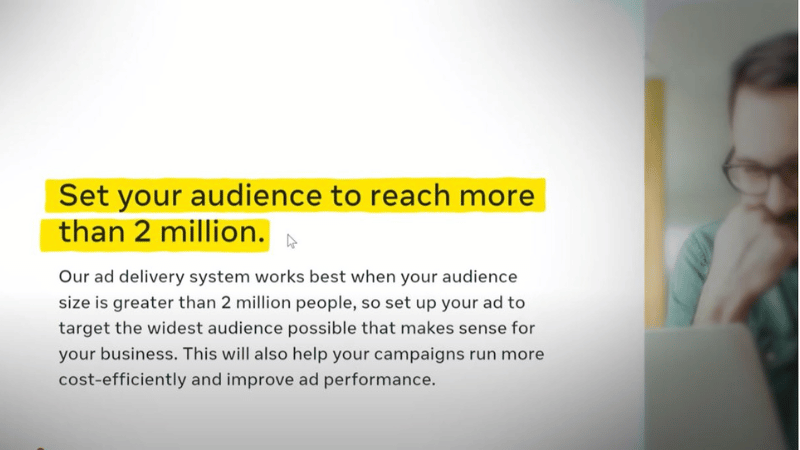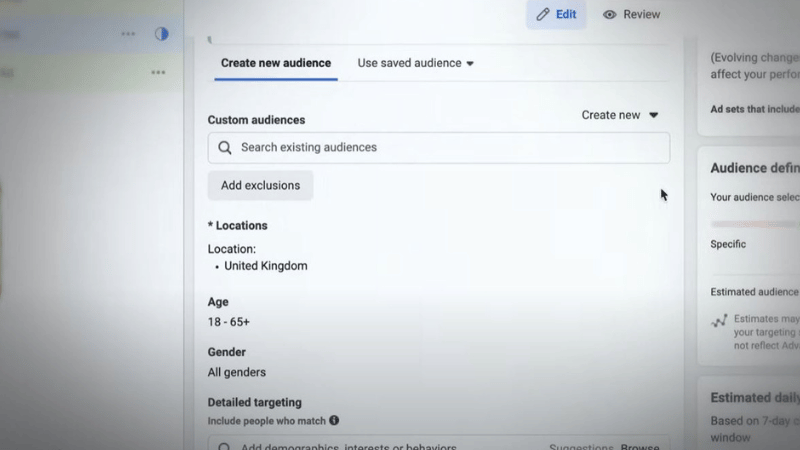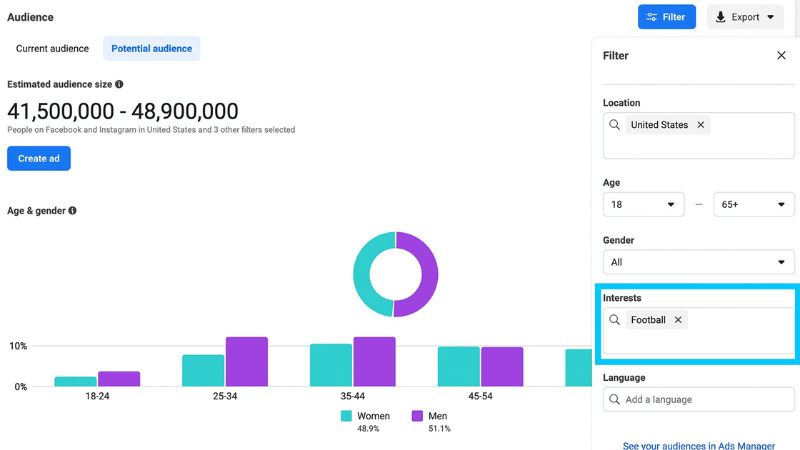Ever wonder how to optimize your Facebook ad audience size? While many advertising experts have debated this issue, there’s no single right answer. The truth is, there’s no 100% correct response to this question. The optimal audience size for your Facebook ads will depend on several factors, including your targeting and the type of campaign you choose to promote.
In recent years, you may have seen a shift in Facebook’s audience size recommendations from Meta, which has been attracting the attention of marketers. Unlike in the past, when Meta rarely provided specific guidance, this time, they have clearly stated that broad targeting with an audience of 2 million or more will help the delivery system optimize better and reduce the average cost per action. This is not just a minor update; it’s a signal that Meta is reshaping its advertising approach, forcing advertisers to quickly adjust their strategies to keep up. Don’t worry, because this blog post will help you solve all your problems, from how to optimize your Facebook ad audience size to allocating your budget to reach the right audience.
A major shift in audience size from Meta

In the past, the recommended audience size was often around 500,000 – 1 million people, but now Meta emphasizes that the minimum size should be over 2 million. This reflects a significant shift in their targeting strategy. Instead of being overly specific, Meta wants advertisers to broaden their reach so the delivery system can work more effectively. According to Meta, when the audience is large enough, the algorithm has more data to analyze, which allows it to automatically select the right people at the right time. This is a sign that advertising on this platform is increasingly dependent on the power of machine learning and artificial intelligence, rather than deep manual intervention by advertisers.
“Broad targeting” is no longer an unfamiliar concept, but with the new recommendation, it has become a central strategy. Instead of adding detailed filters like interests, demographics, or lookalike audiences, you let Meta’s system decide which users in the potential pool are the most suitable to see the ad. This means advertisers can reach millions of people in one campaign, even up to hundreds of millions in populous countries like the US. The recorded result is that the average cost per action (CPA) decreased by about 12% when applying broad targeting, which is proof that the system can optimize better when it has enough data.
When advertisers are too specific, many ad placements are left empty. Conversely, if everyone targets broadly, Meta can easily deliver ads to any group of people on the platform, which helps it maximize revenue. Although Meta benefits, advertisers also benefit. Reaching a larger audience gives campaigns more flexibility, avoiding the limitations of small groups that are often less active. The delivery system can continuously learn, adjust, and select the people who are most likely to convert. More importantly, experiments over the past few years have shown that broad targeting tends to provide more stable results than detailed targeting or lookalike audiences.
Factors affecting audience size
Facebook’s ad system is designed to reach the people who are most interested in your ads. The more relevant the ad is to the objective, the higher the effectiveness. That’s why audience size is quite important. If the audience is too broad, the ads will lack customer interest, and you will have to pay more for each click or view. Conversely, a narrow audience makes it difficult to build a brand, as it doesn’t reach a sufficient number of people to make an impact.

- Your ad objective: The ad objective is the first factor that shapes the audience size. If you want to build brand awareness, the audience size should be as large as possible for the ad to spread. Conversely, if the goal is conversions or sales, you need to narrow the customer base to ensure the ad focuses on the people who are most likely to buy. The more specific the goal, the smaller the audience size will be, and vice versa.
- Budget: The budget also has a strong impact on audience size. With a large budget, you can target millions of people to expand your reach. But if the budget is limited, targeting too broadly can dilute the ad, leading to low effectiveness. Therefore, the budget and audience size need to go hand-in-hand, ensuring that the money spent is enough to “feed” the campaign for the chosen group of people.
- Demographics: Demographics include age, gender, geographic location, and behavioral habits. These factors determine whether you are reaching a broad or narrow customer group. For example, a teenage fashion product will have a much more limited audience than a dietary supplement for adults. Understanding demographic characteristics helps you estimate the size of your potential audience more accurately.
- Industry and Niche: Depending on the industry and market niche, the audience size can change significantly. An FMCG (fast-moving consumer goods) brand typically has an extremely broad audience, while a technology B2B business only focuses on a small group of decision-makers. The specific nature of the industry and niche directly affects whether you should run ads with a broad or narrow audience.
- The type of ad you are running: Finally, the type of ad also determines the audience size. If you are running a video ad to increase awareness, you should choose a large audience size to reach more people. Conversely, if you are running a conversion or remarketing ad, the audience will be smaller because you are only focusing on people who have already shown interest or interacted with your brand. The choice of ad format needs to be tied to the appropriate audience size to achieve optimal results.
Facebook ad audience size: The 2 million+ benchmark
Meta wants advertisers to expand their audience reach, which gives the algorithm more data to work with. This allows it to distribute ads more intelligently and increase the likelihood of finding the right potential customers in the vast sea of users. This change marks a clear step forward. While Meta previously emphasized detailed targeting, encouraging advertisers to filter their audience carefully by demographics, interests, or behaviors, the new direction is the opposite: to broaden the reach. With a benchmark of 2 million people, the ad will have a wider distribution space, allowing the machine learning system to test, learn, and optimize.
The biggest difference lies in the philosophy: instead of “humans deciding,” Meta wants AI and algorithms to take the main role in selecting who sees the ad. This means that advertisers need to have more trust in the platform’s data and automatic optimization capabilities, rather than controlling too much manually. The 2 million number was not chosen randomly. According to Meta, this is a large enough threshold for the system to collect diverse behavioral data while remaining focused enough to avoid diluting the ad. Internal tests have shown that when the audience exceeds this benchmark, the average cost per result (CPA) often decreases significantly, by an average of about 12%.
In addition, 2 million is also considered a “balance point” between effectiveness for advertisers and benefit for Meta. With a large audience pool, Meta can ensure the ad inventory is always filled, while advertisers can leverage the distribution algorithm to optimize costs. This is why the platform encourages the use of broad targeting, viewing it as a sustainable approach in a context where users are becoming increasingly diverse and data is becoming more complex. For countries with small populations, you can certainly set the size below 2 million after adding basic criteria like age and gender. This is just a recommendation from Meta, not a rule. Meta is creating more opportunities for advertisers who are able to target larger, smaller, or in-between audiences.
How to calculate audience size
Audience size tells you how many people your campaign can reach and directly affects its optimization and cost. Meta has adjusted its calculation methods multiple times to fit the platform’s development, and there has recently been a notable change.
How Meta used to calculate it
For many years, Meta relied on fairly specific parameters to estimate audience size. The system is calculated based on monthly active users (MAU) and data from the filters that advertisers added, such as demographics, interests, behaviors, or geographic locations. This meant that if you chose too many detailed criteria, the audience size would decrease sharply, sometimes to just a few thousand people. The estimated number displayed in Ads Manager was then considered to be an almost exact representation of the number of people who could actually see the ad.
Because of this, many advertisers always tried to keep the size in the range of 500,000–1 million people, which was considered the “sweet spot” for the algorithm to optimize. However, the old calculation method also had many limitations. It did not fully reflect the complexity of user behavior and often made advertisers too dependent on detailed targeting. When data was fragmented, the distribution system did not have enough “room” to learn, which led to increased costs and unstable effectiveness.
Meta’s new calculation method
Currently, Meta has changed its approach to Meta ad targeting, and you can learn about it on our blog. Instead of focusing on monthly active user data for each small filter, the system uses a predictive and machine learning model to estimate audience size. This means that instead of saying “how many people exactly match the filter,” Meta is interested in “how many people are suitable for the ad to be displayed to and are likely to engage.” As a result, the estimated audience size has become more flexible and is often larger than before. This is also why Meta recommends that the minimum size should be over 2 million people, giving the AI enough data to automatically optimize.
Notably, Meta no longer encourages overly detailed targeting and instead suggests that advertisers should “let the algorithm do the work.” This change not only helps ad distribution run more smoothly but also expands opportunities for advertisers to reach more potential customer groups. However, it also requires you to change your mindset from manual control to trusting the system’s optimization capabilities more.
From the information above, we will summarize a process to help you optimize your Facebook ad audience size.
How to optimize your Facebook ad audience size

Change your mindset about audience size
- Prioritize large audiences: Meta is recommending that advertisers set their target audience size to over 2 million people. While many people used to worry about the audience being too large, according to Meta, their ad delivery system works most effectively with broader audiences.
- Experiment with Broad Targeting: With the improvements in Meta’s AI and machine learning, using broad targeting (only selecting basic location, age, and gender without adding detailed interests or behaviors) can be more effective. You should experiment with campaigns using broad audiences and compare them with smaller audiences to see the actual results.
Be flexible in choosing the audience size
- Although Meta recommends 2 million people, you should not follow it mechanically. Always make sure the audience you choose is suitable for your business. For example, if you are a local business, targeting the entire country does not make sense.
- Test multiple ad campaigns with smaller audiences. If there is a detailed targeting option (such as a specific interest) that you believe will be effective, you can absolutely try it even if the audience size is under 2 million (e.g., 800,000 or 1 million people). The actual results from your testing will give you the most accurate answer.
Conclusion
Meta is strongly promoting a broad targeting strategy and has issued a new recommendation that the ideal Facebook ad audience size is 2 million people or more. This change reflects Meta’s effort to help the delivery system have enough data to optimize while also serving their own interests in filling their vast ad inventory. However, this is not an absolute number. Advertisers still need to consider their business specifics, market, and budget to decide on an appropriate targeting range. The most important thing is to always test broad targeting against detailed targeting, lookalike audiences, or other options to find the strategy that truly brings the highest effectiveness for each specific campaign.
Frequently Asked Questions
No. Broad targeting often works best for industries with a large potential market, popular products, or brand awareness campaigns. However, for products/services with a very specific niche, such as a type of specialized software for a particular industry, using detailed targeting can be more effective, even if the audience size is less than 2 million.
Yes, ad frequency will tend to be lower when you use a large audience. Frequency is the average number of times a person in your audience sees your ad. When the audience is large, Meta has more people to deliver the ad to, which reduces the chance of one person seeing your ad too many times, thereby preventing ad fatigue. This helps keep the cost per action (CPA) more stable and effective.